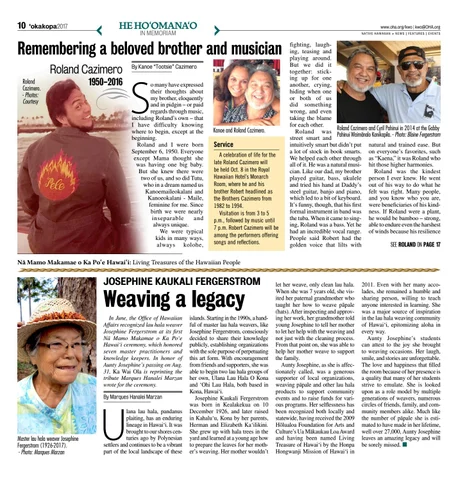10
‘okakopa2017
HE HO‘OMANA‘O
www.oha.org/kwo | kwo@OHA.org
IN MEMORIAM
n at i ve hawa i i a n » n ew s | feat u re s | eve n t s
Remembering a beloved brother and musician Roland Cazimero Roland Cazimero. - Photos: Courtesy
1950-2016
By Kanoe “Tootsie” Cazimero
S
o many have expressed their thoughts about my brother, eloquently and in pidgin – or paid regards through music, including Roland’s own – that I have difficulty knowing where to begin, except at the beginning. Roland and I were born September 6, 1950. Everyone except Mama thought she was having one big baby. But she knew there were two of us, and so did Tutu, who in a dream named us Kanoemaileokalani and Kanoeokalani - Maile, feminine for me. Since birth we were nearly inseparable and always unique. We were typical kids in many ways, always kolohe,
Kanoe and Roland Cazimero.
Service A celebration of life for the late Roland Cazimero will be held Oct. 8 in the Royal Hawaiian Hotel’s Monarch Room, where he and his brother Robert headlined as the Brothers Cazimero from 1982 to 1994. Visitation is from 3 to 5 p.m., followed by music until 7 p.m. Robert Cazimero will be among the performers offering songs and reflections.
fighting, laughing, teasing and playing around. But we did it together: sticking up for one another, crying, hiding when one or both of us did something wrong, and even taking the blame for each other. Roland Cazimero and Cyril Pahinui in 2014 at the Gabby Roland was Pahinui Waima¯nalo Kanikapila. - Photo: Blaine Fergerstrom street smart and intuitively smart but didn’t put natural and trained ease. But a lot of stock in book smarts. on everyone’s favorites, such We helped each other through as “Kaena,” it was Roland who all of it. He was a natural musi- hit those higher harmonies. cian. Like our dad, my brother Roland was the kindest played guitar, bass, ukulele person I ever knew. He went and tried his hand at Daddy’s out of his way to do what he steel guitar, banjo and piano, felt was right. Many people, which led to a bit of keyboard. and you know who you are, It’s funny, though, that his first were beneficiaries of his kindformal instrument in band was ness. If Roland were a plant, the tuba. When it came to sing- he would be bamboo – strong, ing, Roland was a bass. Yet he able to endure even the harshest had an incredible vocal range. of winds because his resilience People said Robert had the golden voice that lilts with See roland on page 17
Na- Mamo Makamae o Ka Po‘e Hawai‘i: Living Treasures of the Hawaiian People
Josephine Kaukali Fergerstrom
Weaving a legacy In June, the Office of Hawaiian Affairs recognized lau hala weaver Josephine Fergerstrom at its first Nä Mamo Makamae o Ka Po‘e Hawai‘i ceremony, which honored seven master practitioners and knowledge keepers. In honor of Aunty Josephine’s passing on Aug. 31, Ka Wai Ola is reprinting the tribute Marques Hanalei Marzan wrote for the ceremony. By Marques Hanalei Marzan
Master lau hala weaver Josephine Fergerstrom (1926-2017). - Photo: Marques Marzan
U
lana lau hala, pandanus plaiting, has an enduring lineage in Hawai‘i. It was brought to our shores centuries ago by Polynesian settlers and continues to be a vibrant part of the local landscape of these
islands. Starting in the 1990s, a handful of master lau hala weavers, like Josephine Fergerstrom, consciously decided to share their knowledge publicly, establishing organizations with the sole purpose of perpetuating this art form. With encouragement from friends and supporters, she was able to begin two lau hala groups of her own, Ulana Lau Hala O Kona and ‘Ohi Lau Hala, both based in Kona, Hawai‘i. Josephine Kaukali Fergerstrom was born in Kealakekua on 10 December 1926, and later raised in Kahalu‘u, Kona by her parents, Herman and Elizabeth Ka‘ilikini. She grew up with hala trees in the yard and learned at a young age how to prepare the leaves for her mother’s weaving. Her mother wouldn’t
let her weave, only clean lau hala. When she was 7 years old, she visited her paternal grandmother who taught her how to weave päpale (hats). After inspecting and approving her work, her grandmother told young Josephine to tell her mother to let her help with the weaving and not just with the cleaning process. From that point on, she was able to help her mother weave to support the family. Aunty Josephine, as she is affectionately called, was a generous supporter of local organizations, weaving päpale and other lau hala products to support community events and to raise funds for various programs. Her selflessness has been recognized both locally and statewide, having received the 2009 Hölualoa Foundation for Arts and Culture’s Ua Mäkaukau Loa Award and having been named Living Treasure of Hawai‘i by the Honpa Hongwanji Mission of Hawai‘i in
2011. Even with her many accolades, she remained a humble and sharing person, willing to teach anyone interested in learning. She was a major source of inspiration in the lau hala weaving community of Hawai‘i, epitomizing aloha in every way. Aunty Josephine’s students can attest to the joy she brought to weaving occasions. Her laugh, smile, and stories are unforgettable. The love and happiness that filled the room because of her presence is a quality that many of her students strive to emulate. She is looked upon as a role model by multiple generations of weavers, numerous circles of friends, family, and community members alike. Much like the number of päpale she is estimated to have made in her lifetime, well over 27,000, Aunty Josephine leaves an amazing legacy and will be sorely missed. ¢


